Business Environment Executive Summary 2022
VerifiedAdded on 2022/09/16
|15
|3248
|15
AI Summary
Contribute Materials
Your contribution can guide someone’s learning journey. Share your
documents today.
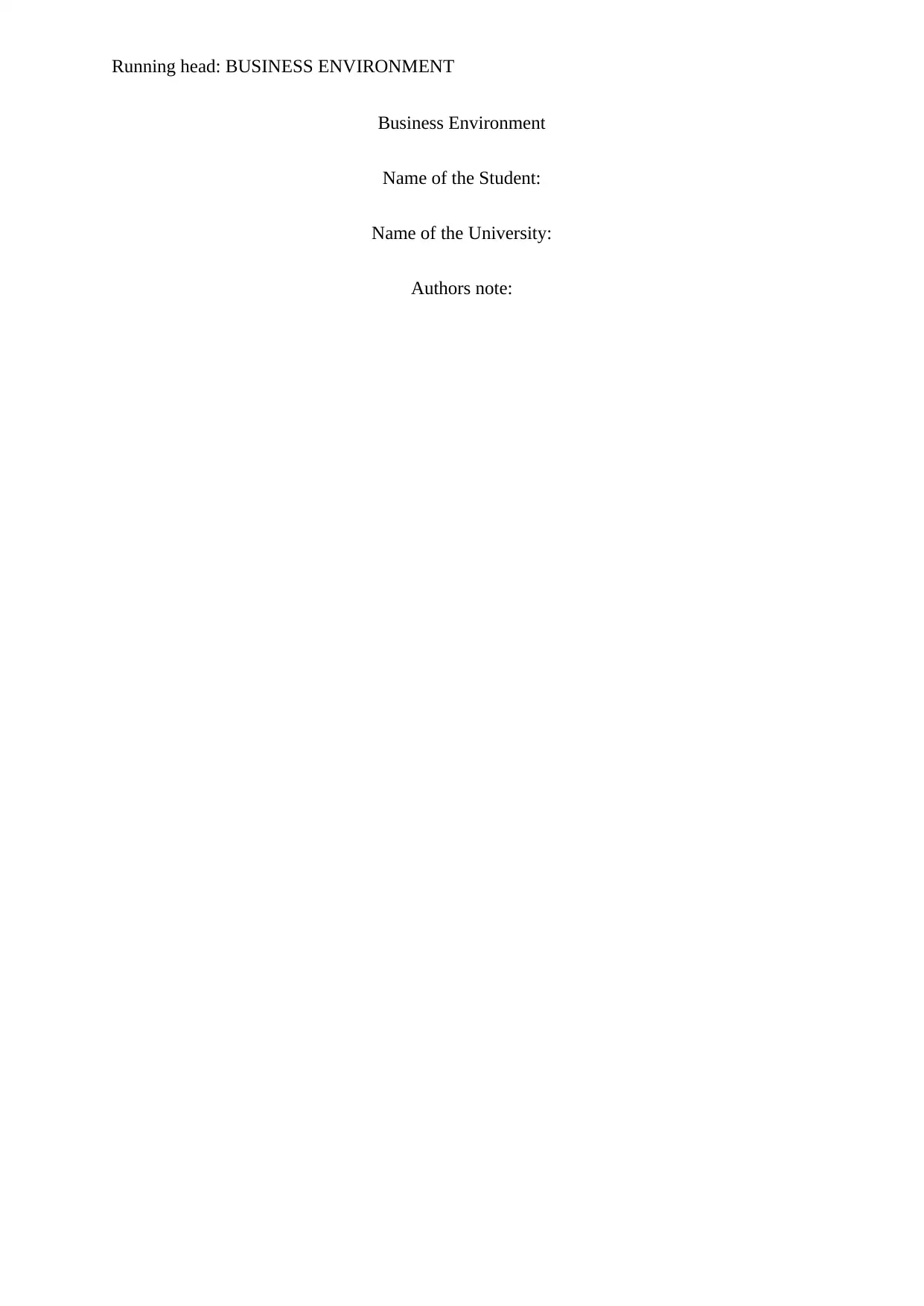
Running head: BUSINESS ENVIRONMENT
Business Environment
Name of the Student:
Name of the University:
Authors note:
Business Environment
Name of the Student:
Name of the University:
Authors note:
Secure Best Marks with AI Grader
Need help grading? Try our AI Grader for instant feedback on your assignments.
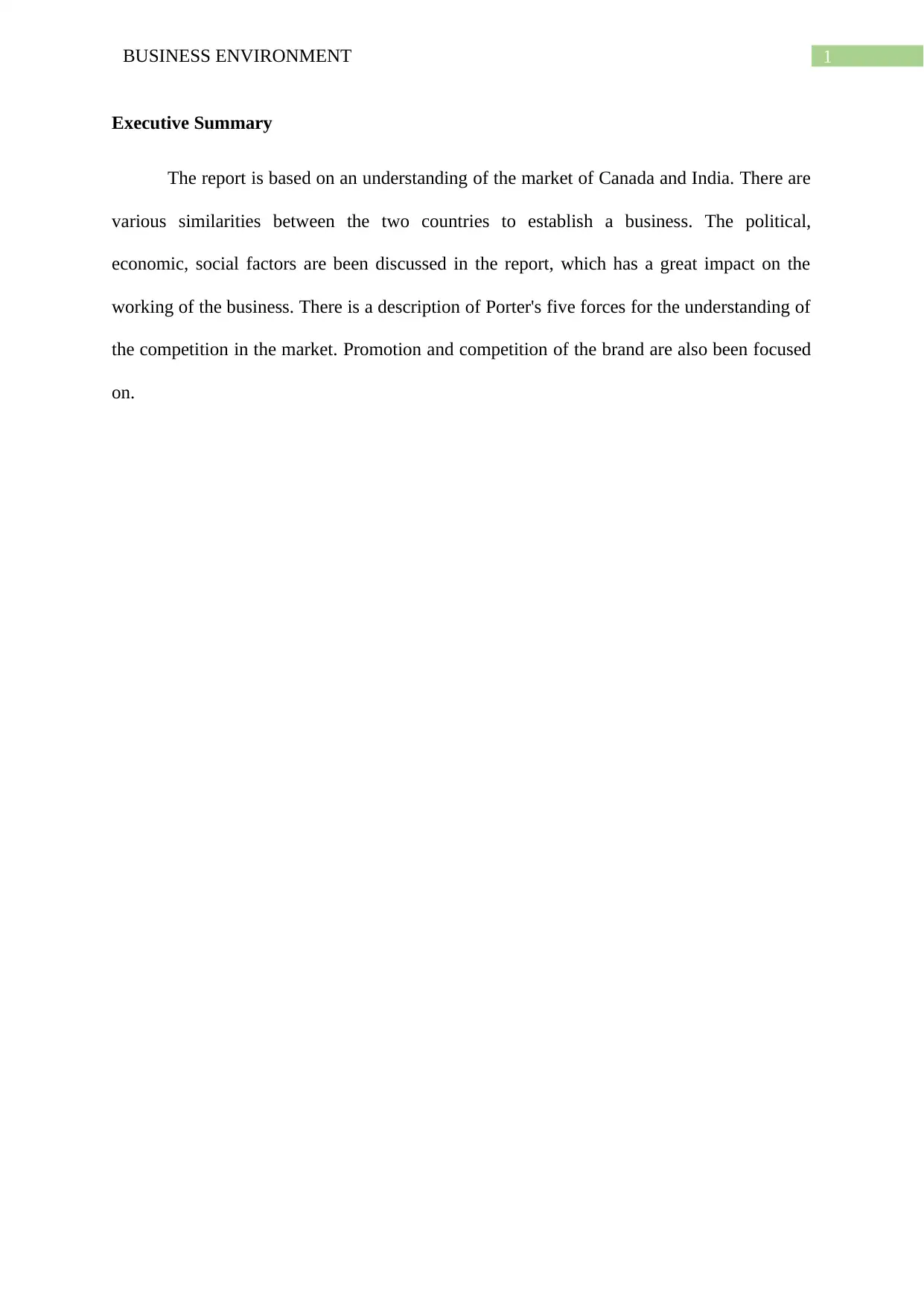
1BUSINESS ENVIRONMENT
Executive Summary
The report is based on an understanding of the market of Canada and India. There are
various similarities between the two countries to establish a business. The political,
economic, social factors are been discussed in the report, which has a great impact on the
working of the business. There is a description of Porter's five forces for the understanding of
the competition in the market. Promotion and competition of the brand are also been focused
on.
Executive Summary
The report is based on an understanding of the market of Canada and India. There are
various similarities between the two countries to establish a business. The political,
economic, social factors are been discussed in the report, which has a great impact on the
working of the business. There is a description of Porter's five forces for the understanding of
the competition in the market. Promotion and competition of the brand are also been focused
on.
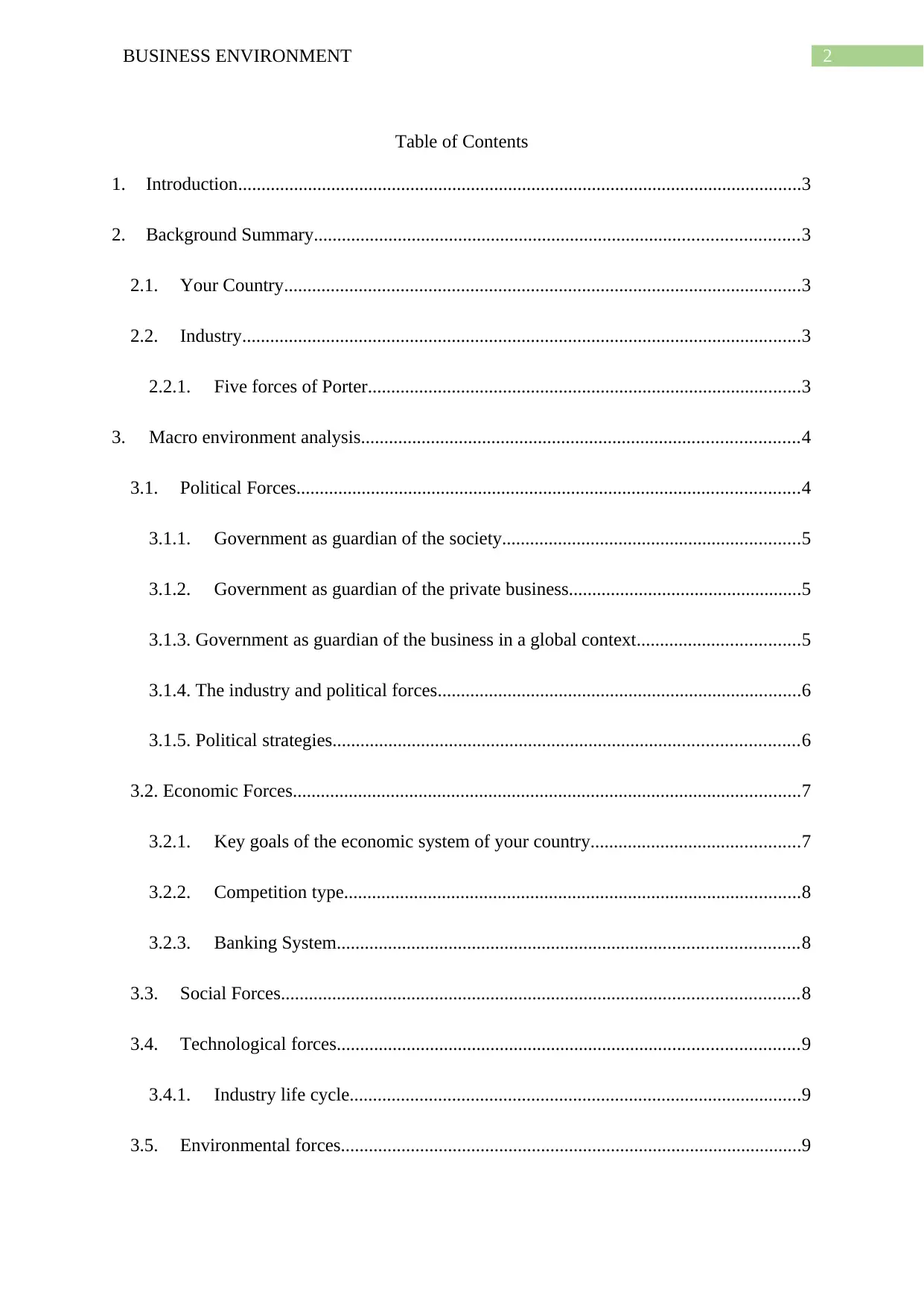
2BUSINESS ENVIRONMENT
Table of Contents
1. Introduction.........................................................................................................................3
2. Background Summary........................................................................................................3
2.1. Your Country...............................................................................................................3
2.2. Industry........................................................................................................................3
2.2.1. Five forces of Porter.............................................................................................3
3. Macro environment analysis..............................................................................................4
3.1. Political Forces............................................................................................................4
3.1.1. Government as guardian of the society................................................................5
3.1.2. Government as guardian of the private business..................................................5
3.1.3. Government as guardian of the business in a global context...................................5
3.1.4. The industry and political forces..............................................................................6
3.1.5. Political strategies....................................................................................................6
3.2. Economic Forces.............................................................................................................7
3.2.1. Key goals of the economic system of your country.............................................7
3.2.2. Competition type..................................................................................................8
3.2.3. Banking System...................................................................................................8
3.3. Social Forces...............................................................................................................8
3.4. Technological forces...................................................................................................9
3.4.1. Industry life cycle.................................................................................................9
3.5. Environmental forces...................................................................................................9
Table of Contents
1. Introduction.........................................................................................................................3
2. Background Summary........................................................................................................3
2.1. Your Country...............................................................................................................3
2.2. Industry........................................................................................................................3
2.2.1. Five forces of Porter.............................................................................................3
3. Macro environment analysis..............................................................................................4
3.1. Political Forces............................................................................................................4
3.1.1. Government as guardian of the society................................................................5
3.1.2. Government as guardian of the private business..................................................5
3.1.3. Government as guardian of the business in a global context...................................5
3.1.4. The industry and political forces..............................................................................6
3.1.5. Political strategies....................................................................................................6
3.2. Economic Forces.............................................................................................................7
3.2.1. Key goals of the economic system of your country.............................................7
3.2.2. Competition type..................................................................................................8
3.2.3. Banking System...................................................................................................8
3.3. Social Forces...............................................................................................................8
3.4. Technological forces...................................................................................................9
3.4.1. Industry life cycle.................................................................................................9
3.5. Environmental forces...................................................................................................9
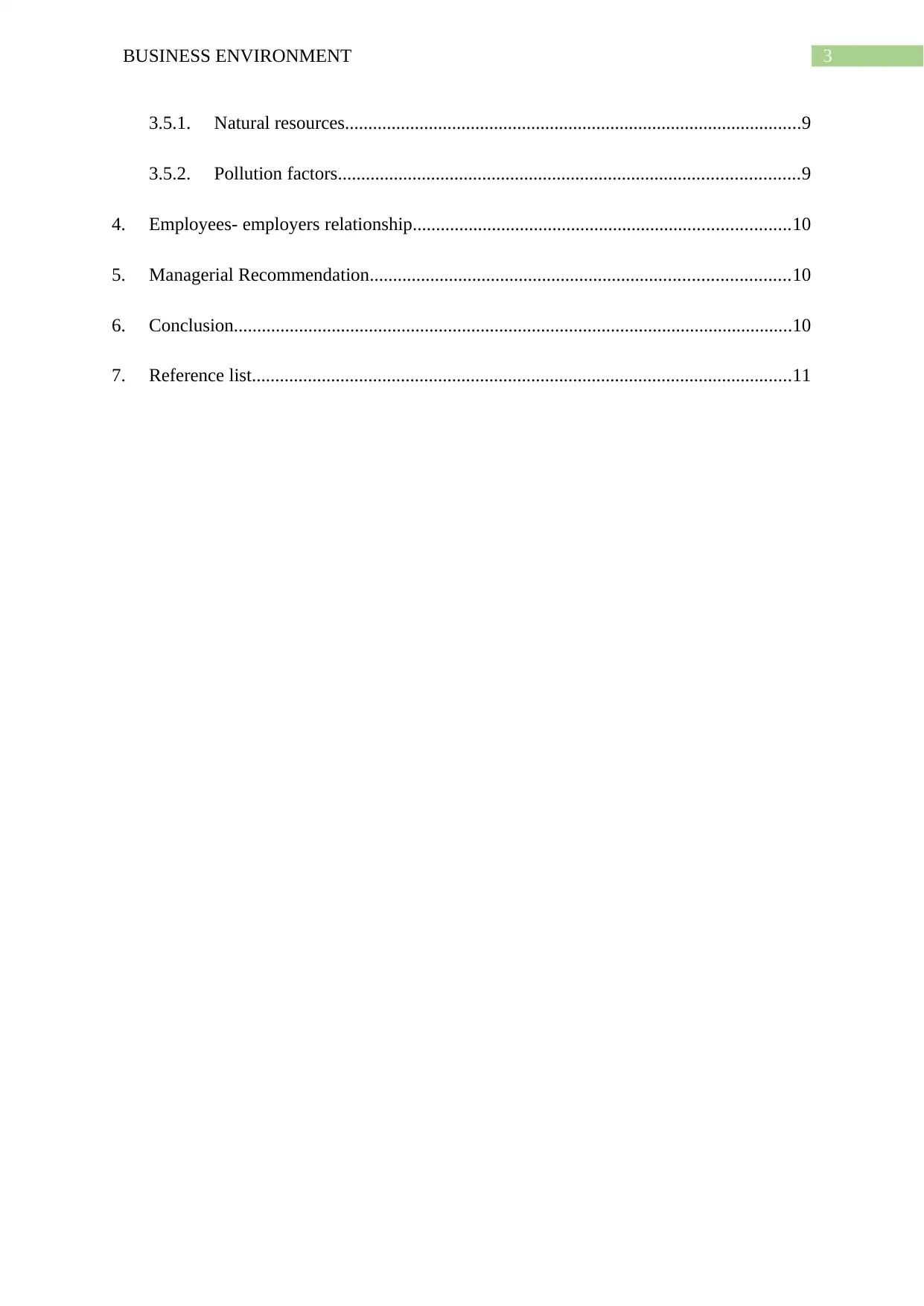
3BUSINESS ENVIRONMENT
3.5.1. Natural resources..................................................................................................9
3.5.2. Pollution factors...................................................................................................9
4. Employees- employers relationship.................................................................................10
5. Managerial Recommendation..........................................................................................10
6. Conclusion........................................................................................................................10
7. Reference list....................................................................................................................11
3.5.1. Natural resources..................................................................................................9
3.5.2. Pollution factors...................................................................................................9
4. Employees- employers relationship.................................................................................10
5. Managerial Recommendation..........................................................................................10
6. Conclusion........................................................................................................................10
7. Reference list....................................................................................................................11
Secure Best Marks with AI Grader
Need help grading? Try our AI Grader for instant feedback on your assignments.
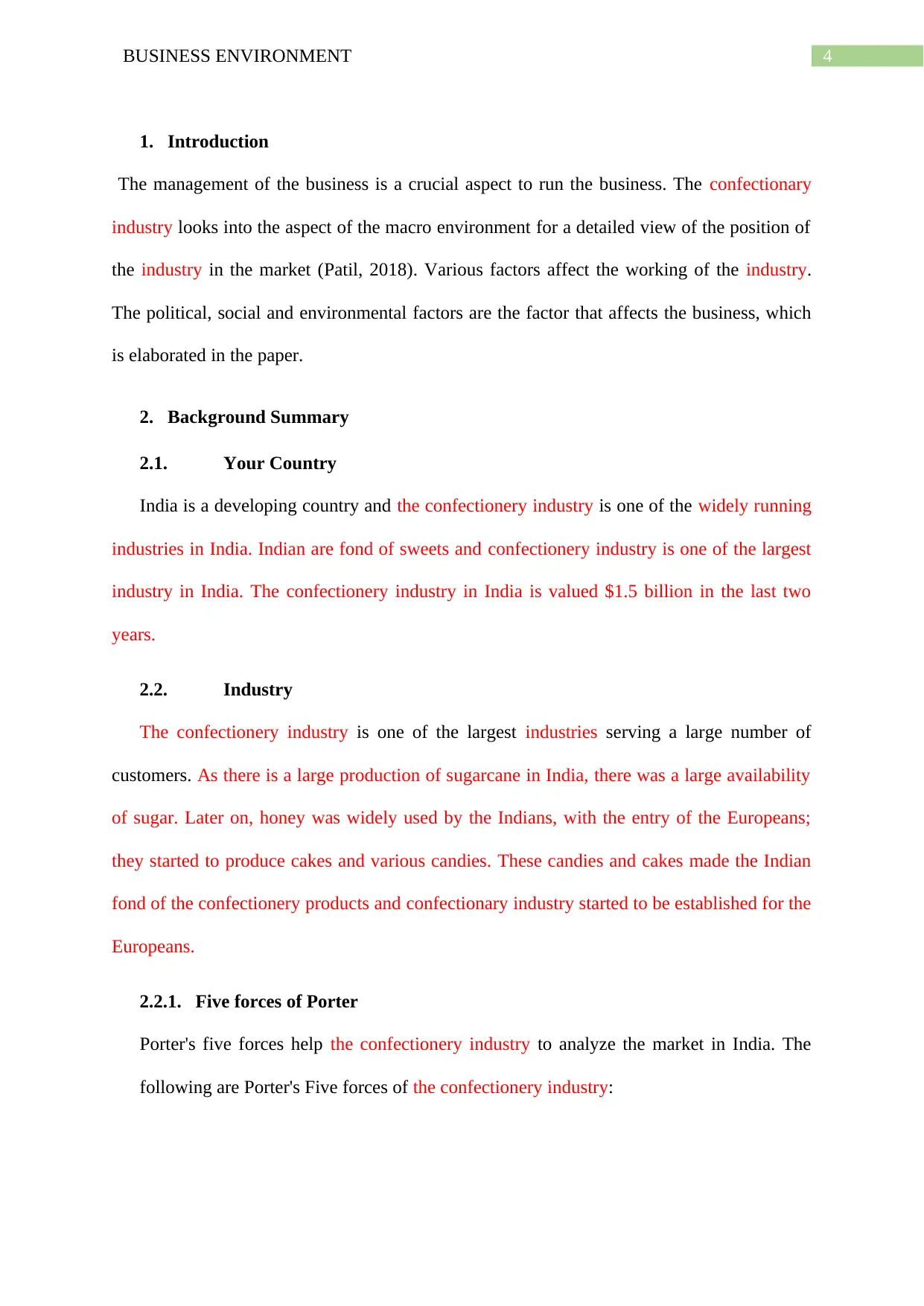
4BUSINESS ENVIRONMENT
1. Introduction
The management of the business is a crucial aspect to run the business. The confectionary
industry looks into the aspect of the macro environment for a detailed view of the position of
the industry in the market (Patil, 2018). Various factors affect the working of the industry.
The political, social and environmental factors are the factor that affects the business, which
is elaborated in the paper.
2. Background Summary
2.1. Your Country
India is a developing country and the confectionery industry is one of the widely running
industries in India. Indian are fond of sweets and confectionery industry is one of the largest
industry in India. The confectionery industry in India is valued $1.5 billion in the last two
years.
2.2. Industry
The confectionery industry is one of the largest industries serving a large number of
customers. As there is a large production of sugarcane in India, there was a large availability
of sugar. Later on, honey was widely used by the Indians, with the entry of the Europeans;
they started to produce cakes and various candies. These candies and cakes made the Indian
fond of the confectionery products and confectionary industry started to be established for the
Europeans.
2.2.1. Five forces of Porter
Porter's five forces help the confectionery industry to analyze the market in India. The
following are Porter's Five forces of the confectionery industry:
1. Introduction
The management of the business is a crucial aspect to run the business. The confectionary
industry looks into the aspect of the macro environment for a detailed view of the position of
the industry in the market (Patil, 2018). Various factors affect the working of the industry.
The political, social and environmental factors are the factor that affects the business, which
is elaborated in the paper.
2. Background Summary
2.1. Your Country
India is a developing country and the confectionery industry is one of the widely running
industries in India. Indian are fond of sweets and confectionery industry is one of the largest
industry in India. The confectionery industry in India is valued $1.5 billion in the last two
years.
2.2. Industry
The confectionery industry is one of the largest industries serving a large number of
customers. As there is a large production of sugarcane in India, there was a large availability
of sugar. Later on, honey was widely used by the Indians, with the entry of the Europeans;
they started to produce cakes and various candies. These candies and cakes made the Indian
fond of the confectionery products and confectionary industry started to be established for the
Europeans.
2.2.1. Five forces of Porter
Porter's five forces help the confectionery industry to analyze the market in India. The
following are Porter's Five forces of the confectionery industry:
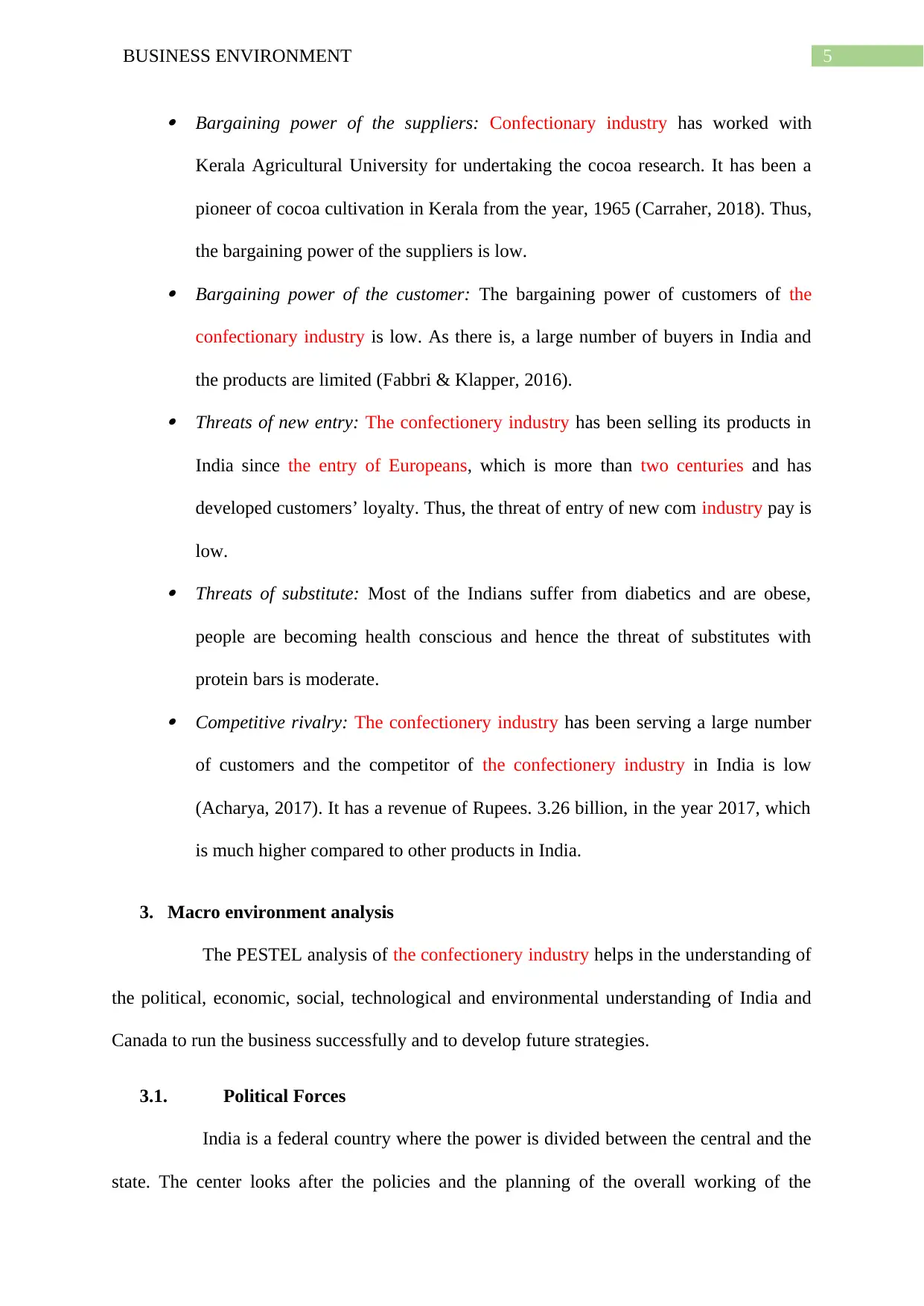
5BUSINESS ENVIRONMENT
Bargaining power of the suppliers: Confectionary industry has worked with
Kerala Agricultural University for undertaking the cocoa research. It has been a
pioneer of cocoa cultivation in Kerala from the year, 1965 (Carraher, 2018). Thus,
the bargaining power of the suppliers is low. Bargaining power of the customer: The bargaining power of customers of the
confectionary industry is low. As there is, a large number of buyers in India and
the products are limited (Fabbri & Klapper, 2016). Threats of new entry: The confectionery industry has been selling its products in
India since the entry of Europeans, which is more than two centuries and has
developed customers’ loyalty. Thus, the threat of entry of new com industry pay is
low. Threats of substitute: Most of the Indians suffer from diabetics and are obese,
people are becoming health conscious and hence the threat of substitutes with
protein bars is moderate. Competitive rivalry: The confectionery industry has been serving a large number
of customers and the competitor of the confectionery industry in India is low
(Acharya, 2017). It has a revenue of Rupees. 3.26 billion, in the year 2017, which
is much higher compared to other products in India.
3. Macro environment analysis
The PESTEL analysis of the confectionery industry helps in the understanding of
the political, economic, social, technological and environmental understanding of India and
Canada to run the business successfully and to develop future strategies.
3.1. Political Forces
India is a federal country where the power is divided between the central and the
state. The center looks after the policies and the planning of the overall working of the
Bargaining power of the suppliers: Confectionary industry has worked with
Kerala Agricultural University for undertaking the cocoa research. It has been a
pioneer of cocoa cultivation in Kerala from the year, 1965 (Carraher, 2018). Thus,
the bargaining power of the suppliers is low. Bargaining power of the customer: The bargaining power of customers of the
confectionary industry is low. As there is, a large number of buyers in India and
the products are limited (Fabbri & Klapper, 2016). Threats of new entry: The confectionery industry has been selling its products in
India since the entry of Europeans, which is more than two centuries and has
developed customers’ loyalty. Thus, the threat of entry of new com industry pay is
low. Threats of substitute: Most of the Indians suffer from diabetics and are obese,
people are becoming health conscious and hence the threat of substitutes with
protein bars is moderate. Competitive rivalry: The confectionery industry has been serving a large number
of customers and the competitor of the confectionery industry in India is low
(Acharya, 2017). It has a revenue of Rupees. 3.26 billion, in the year 2017, which
is much higher compared to other products in India.
3. Macro environment analysis
The PESTEL analysis of the confectionery industry helps in the understanding of
the political, economic, social, technological and environmental understanding of India and
Canada to run the business successfully and to develop future strategies.
3.1. Political Forces
India is a federal country where the power is divided between the central and the
state. The center looks after the policies and the planning of the overall working of the
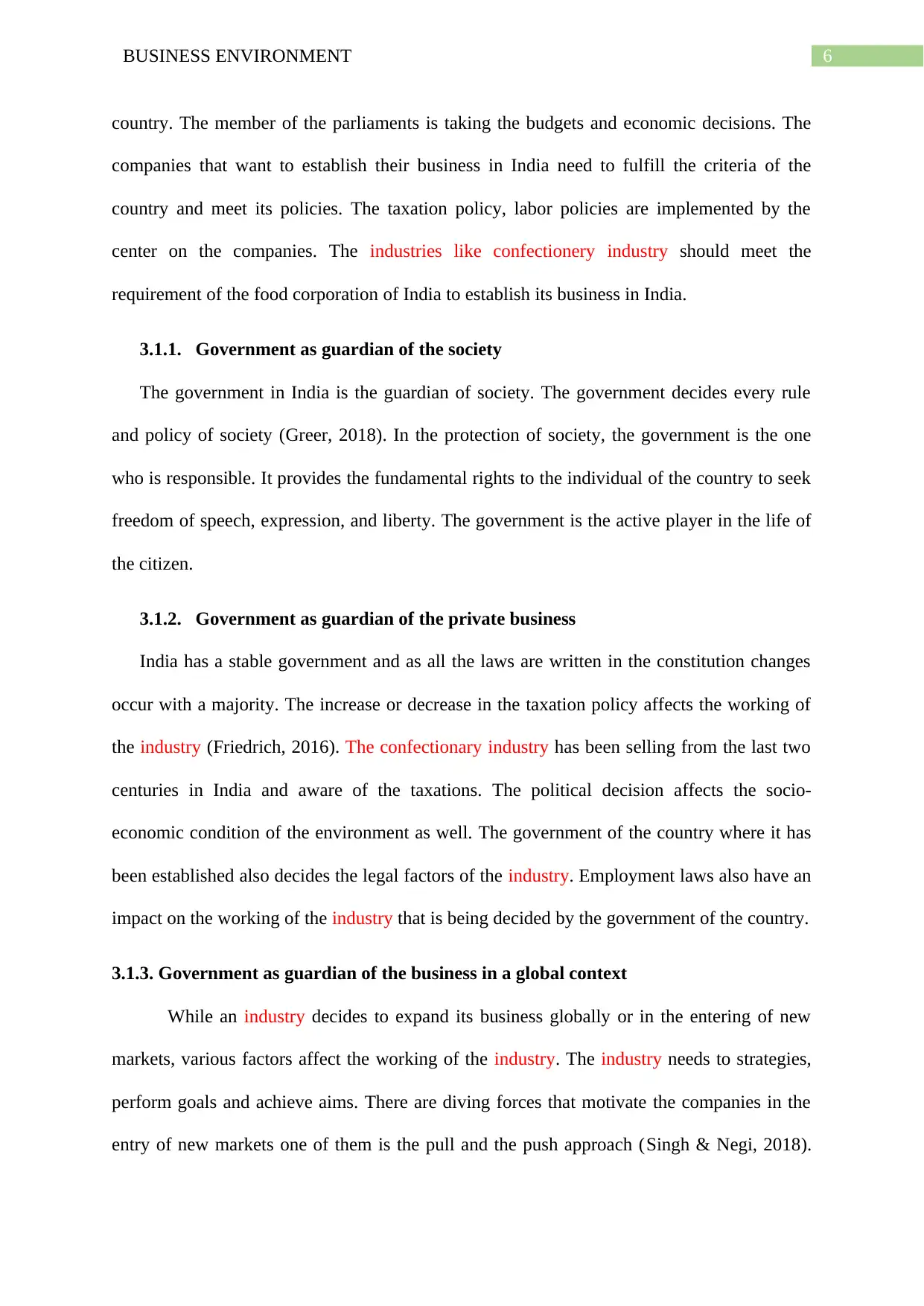
6BUSINESS ENVIRONMENT
country. The member of the parliaments is taking the budgets and economic decisions. The
companies that want to establish their business in India need to fulfill the criteria of the
country and meet its policies. The taxation policy, labor policies are implemented by the
center on the companies. The industries like confectionery industry should meet the
requirement of the food corporation of India to establish its business in India.
3.1.1. Government as guardian of the society
The government in India is the guardian of society. The government decides every rule
and policy of society (Greer, 2018). In the protection of society, the government is the one
who is responsible. It provides the fundamental rights to the individual of the country to seek
freedom of speech, expression, and liberty. The government is the active player in the life of
the citizen.
3.1.2. Government as guardian of the private business
India has a stable government and as all the laws are written in the constitution changes
occur with a majority. The increase or decrease in the taxation policy affects the working of
the industry (Friedrich, 2016). The confectionary industry has been selling from the last two
centuries in India and aware of the taxations. The political decision affects the socio-
economic condition of the environment as well. The government of the country where it has
been established also decides the legal factors of the industry. Employment laws also have an
impact on the working of the industry that is being decided by the government of the country.
3.1.3. Government as guardian of the business in a global context
While an industry decides to expand its business globally or in the entering of new
markets, various factors affect the working of the industry. The industry needs to strategies,
perform goals and achieve aims. There are diving forces that motivate the companies in the
entry of new markets one of them is the pull and the push approach (Singh & Negi, 2018).
country. The member of the parliaments is taking the budgets and economic decisions. The
companies that want to establish their business in India need to fulfill the criteria of the
country and meet its policies. The taxation policy, labor policies are implemented by the
center on the companies. The industries like confectionery industry should meet the
requirement of the food corporation of India to establish its business in India.
3.1.1. Government as guardian of the society
The government in India is the guardian of society. The government decides every rule
and policy of society (Greer, 2018). In the protection of society, the government is the one
who is responsible. It provides the fundamental rights to the individual of the country to seek
freedom of speech, expression, and liberty. The government is the active player in the life of
the citizen.
3.1.2. Government as guardian of the private business
India has a stable government and as all the laws are written in the constitution changes
occur with a majority. The increase or decrease in the taxation policy affects the working of
the industry (Friedrich, 2016). The confectionary industry has been selling from the last two
centuries in India and aware of the taxations. The political decision affects the socio-
economic condition of the environment as well. The government of the country where it has
been established also decides the legal factors of the industry. Employment laws also have an
impact on the working of the industry that is being decided by the government of the country.
3.1.3. Government as guardian of the business in a global context
While an industry decides to expand its business globally or in the entering of new
markets, various factors affect the working of the industry. The industry needs to strategies,
perform goals and achieve aims. There are diving forces that motivate the companies in the
entry of new markets one of them is the pull and the push approach (Singh & Negi, 2018).
Paraphrase This Document
Need a fresh take? Get an instant paraphrase of this document with our AI Paraphraser
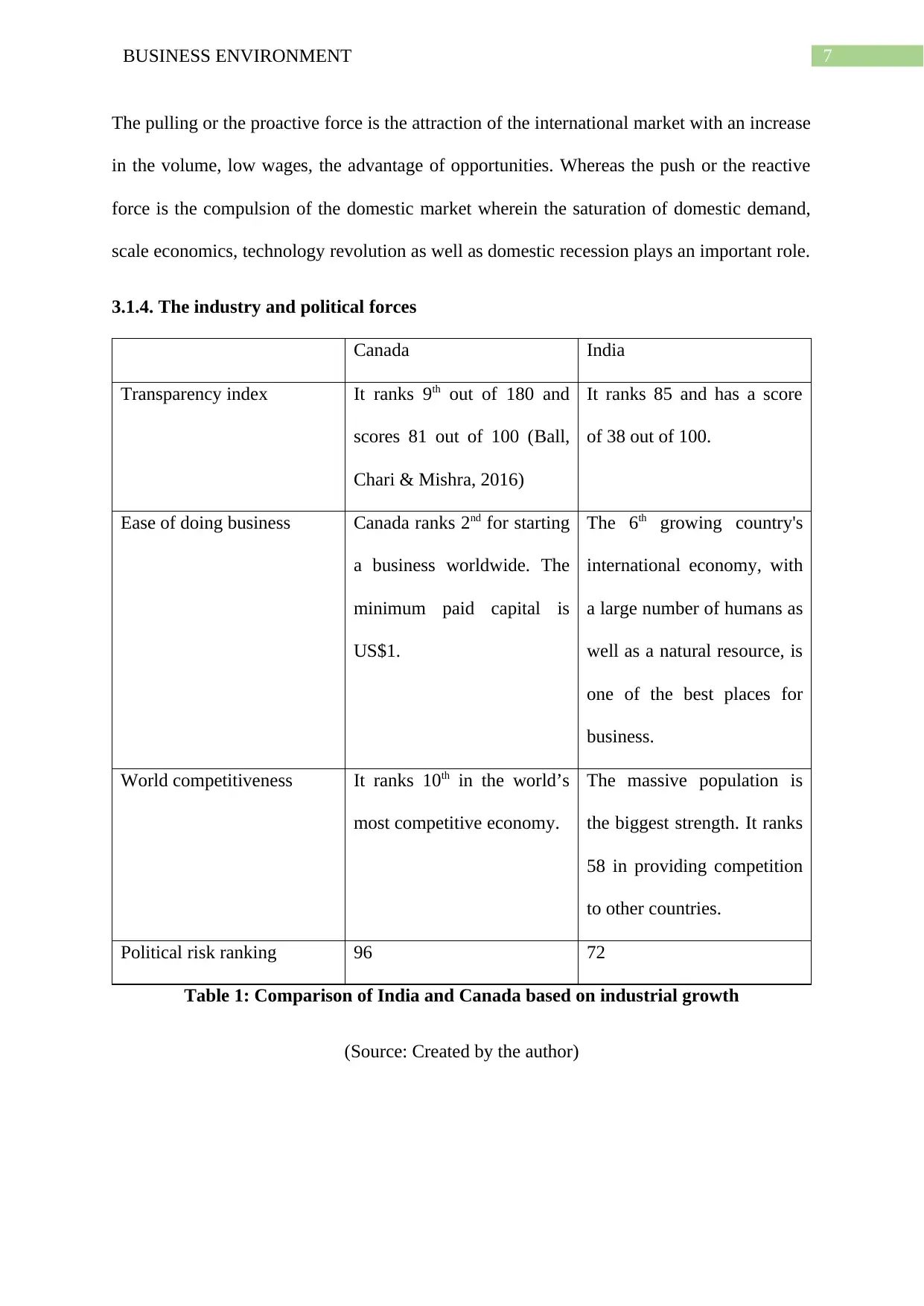
7BUSINESS ENVIRONMENT
The pulling or the proactive force is the attraction of the international market with an increase
in the volume, low wages, the advantage of opportunities. Whereas the push or the reactive
force is the compulsion of the domestic market wherein the saturation of domestic demand,
scale economics, technology revolution as well as domestic recession plays an important role.
3.1.4. The industry and political forces
Canada India
Transparency index It ranks 9th out of 180 and
scores 81 out of 100 (Ball,
Chari & Mishra, 2016)
It ranks 85 and has a score
of 38 out of 100.
Ease of doing business Canada ranks 2nd for starting
a business worldwide. The
minimum paid capital is
US$1.
The 6th growing country's
international economy, with
a large number of humans as
well as a natural resource, is
one of the best places for
business.
World competitiveness It ranks 10th in the world’s
most competitive economy.
The massive population is
the biggest strength. It ranks
58 in providing competition
to other countries.
Political risk ranking 96 72
Table 1: Comparison of India and Canada based on industrial growth
(Source: Created by the author)
The pulling or the proactive force is the attraction of the international market with an increase
in the volume, low wages, the advantage of opportunities. Whereas the push or the reactive
force is the compulsion of the domestic market wherein the saturation of domestic demand,
scale economics, technology revolution as well as domestic recession plays an important role.
3.1.4. The industry and political forces
Canada India
Transparency index It ranks 9th out of 180 and
scores 81 out of 100 (Ball,
Chari & Mishra, 2016)
It ranks 85 and has a score
of 38 out of 100.
Ease of doing business Canada ranks 2nd for starting
a business worldwide. The
minimum paid capital is
US$1.
The 6th growing country's
international economy, with
a large number of humans as
well as a natural resource, is
one of the best places for
business.
World competitiveness It ranks 10th in the world’s
most competitive economy.
The massive population is
the biggest strength. It ranks
58 in providing competition
to other countries.
Political risk ranking 96 72
Table 1: Comparison of India and Canada based on industrial growth
(Source: Created by the author)
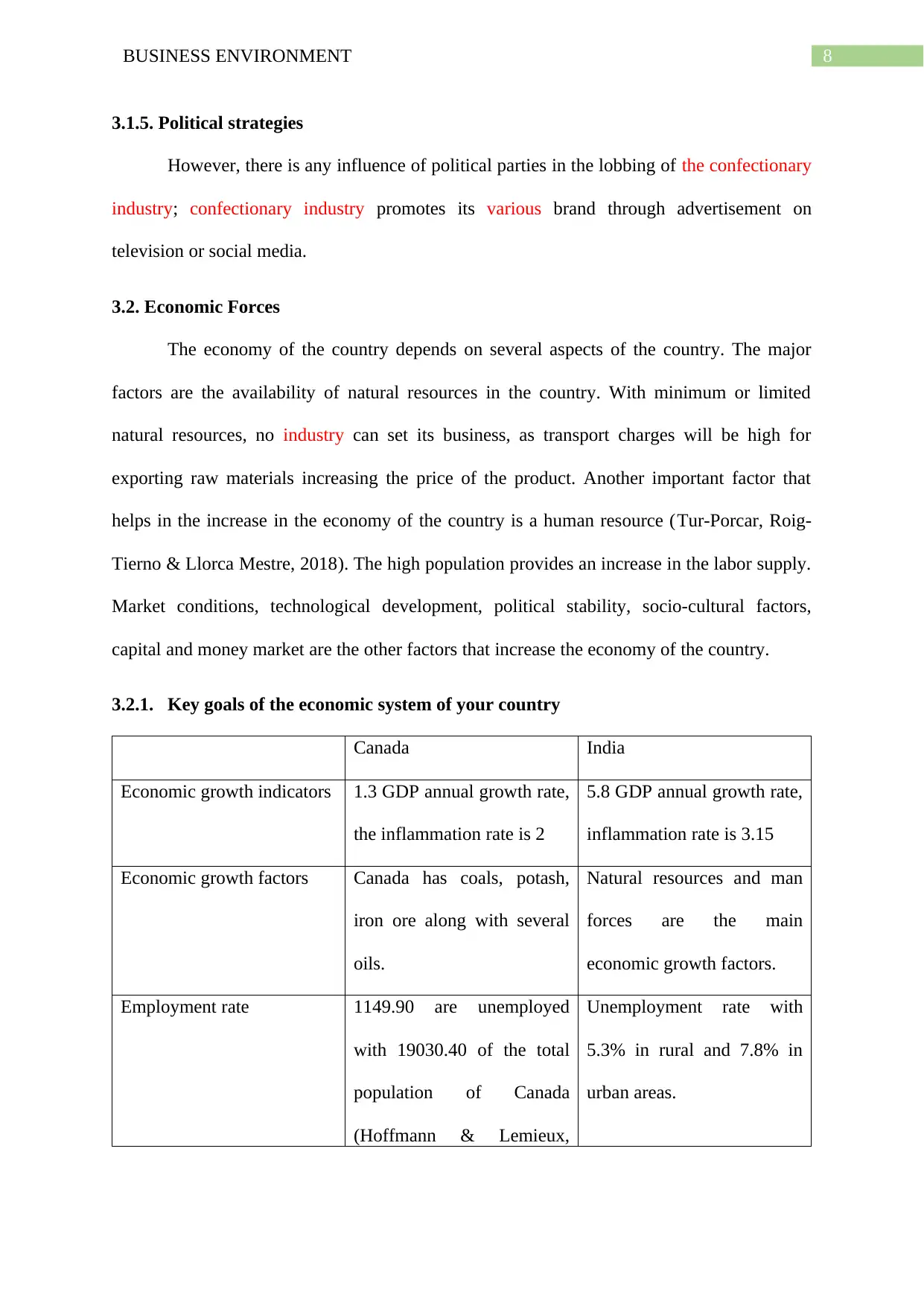
8BUSINESS ENVIRONMENT
3.1.5. Political strategies
However, there is any influence of political parties in the lobbing of the confectionary
industry; confectionary industry promotes its various brand through advertisement on
television or social media.
3.2. Economic Forces
The economy of the country depends on several aspects of the country. The major
factors are the availability of natural resources in the country. With minimum or limited
natural resources, no industry can set its business, as transport charges will be high for
exporting raw materials increasing the price of the product. Another important factor that
helps in the increase in the economy of the country is a human resource (Tur-Porcar, Roig-
Tierno & Llorca Mestre, 2018). The high population provides an increase in the labor supply.
Market conditions, technological development, political stability, socio-cultural factors,
capital and money market are the other factors that increase the economy of the country.
3.2.1. Key goals of the economic system of your country
Canada India
Economic growth indicators 1.3 GDP annual growth rate,
the inflammation rate is 2
5.8 GDP annual growth rate,
inflammation rate is 3.15
Economic growth factors Canada has coals, potash,
iron ore along with several
oils.
Natural resources and man
forces are the main
economic growth factors.
Employment rate 1149.90 are unemployed
with 19030.40 of the total
population of Canada
(Hoffmann & Lemieux,
Unemployment rate with
5.3% in rural and 7.8% in
urban areas.
3.1.5. Political strategies
However, there is any influence of political parties in the lobbing of the confectionary
industry; confectionary industry promotes its various brand through advertisement on
television or social media.
3.2. Economic Forces
The economy of the country depends on several aspects of the country. The major
factors are the availability of natural resources in the country. With minimum or limited
natural resources, no industry can set its business, as transport charges will be high for
exporting raw materials increasing the price of the product. Another important factor that
helps in the increase in the economy of the country is a human resource (Tur-Porcar, Roig-
Tierno & Llorca Mestre, 2018). The high population provides an increase in the labor supply.
Market conditions, technological development, political stability, socio-cultural factors,
capital and money market are the other factors that increase the economy of the country.
3.2.1. Key goals of the economic system of your country
Canada India
Economic growth indicators 1.3 GDP annual growth rate,
the inflammation rate is 2
5.8 GDP annual growth rate,
inflammation rate is 3.15
Economic growth factors Canada has coals, potash,
iron ore along with several
oils.
Natural resources and man
forces are the main
economic growth factors.
Employment rate 1149.90 are unemployed
with 19030.40 of the total
population of Canada
(Hoffmann & Lemieux,
Unemployment rate with
5.3% in rural and 7.8% in
urban areas.
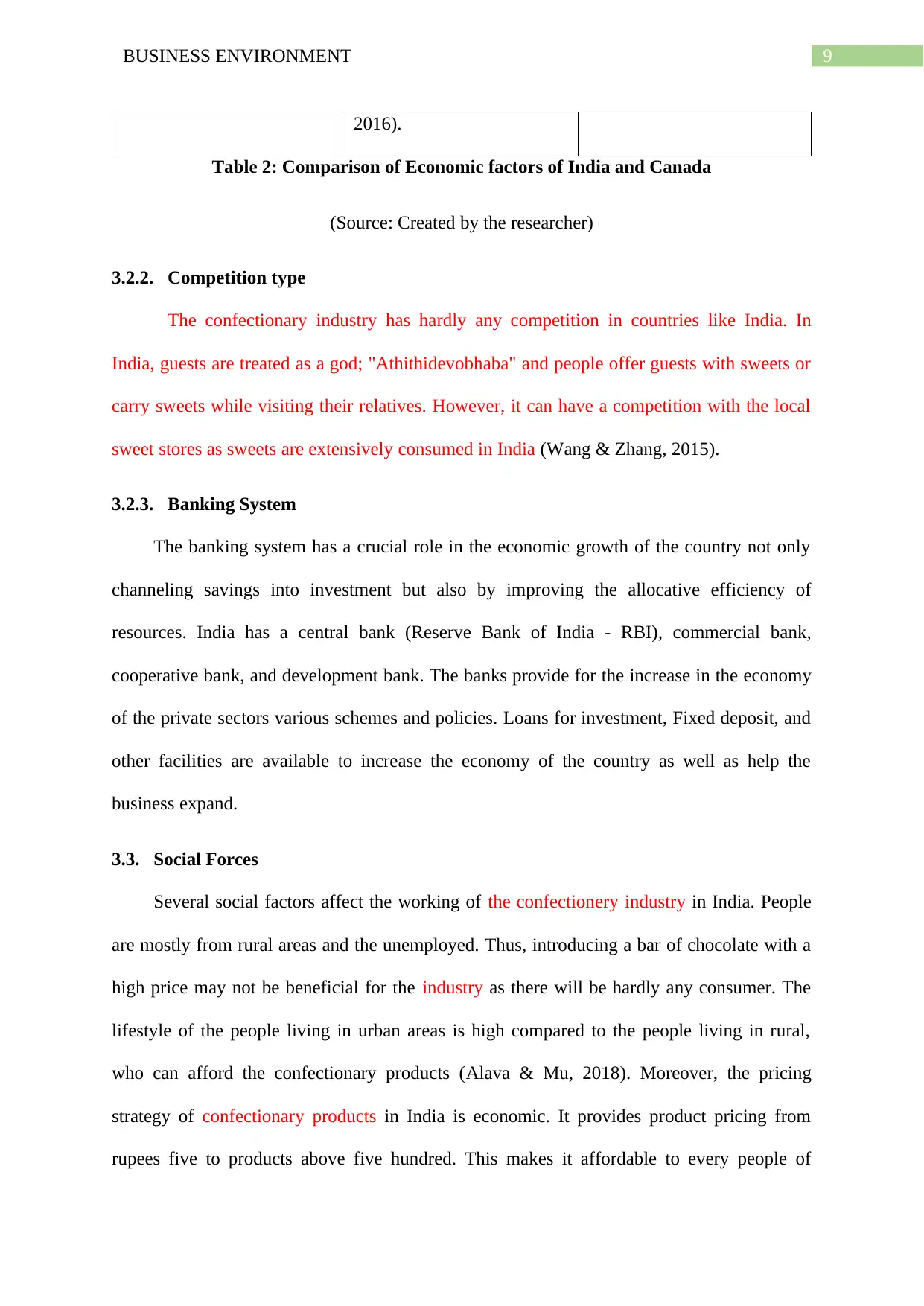
9BUSINESS ENVIRONMENT
2016).
Table 2: Comparison of Economic factors of India and Canada
(Source: Created by the researcher)
3.2.2. Competition type
The confectionary industry has hardly any competition in countries like India. In
India, guests are treated as a god; "Athithidevobhaba" and people offer guests with sweets or
carry sweets while visiting their relatives. However, it can have a competition with the local
sweet stores as sweets are extensively consumed in India (Wang & Zhang, 2015).
3.2.3. Banking System
The banking system has a crucial role in the economic growth of the country not only
channeling savings into investment but also by improving the allocative efficiency of
resources. India has a central bank (Reserve Bank of India - RBI), commercial bank,
cooperative bank, and development bank. The banks provide for the increase in the economy
of the private sectors various schemes and policies. Loans for investment, Fixed deposit, and
other facilities are available to increase the economy of the country as well as help the
business expand.
3.3. Social Forces
Several social factors affect the working of the confectionery industry in India. People
are mostly from rural areas and the unemployed. Thus, introducing a bar of chocolate with a
high price may not be beneficial for the industry as there will be hardly any consumer. The
lifestyle of the people living in urban areas is high compared to the people living in rural,
who can afford the confectionary products (Alava & Mu, 2018). Moreover, the pricing
strategy of confectionary products in India is economic. It provides product pricing from
rupees five to products above five hundred. This makes it affordable to every people of
2016).
Table 2: Comparison of Economic factors of India and Canada
(Source: Created by the researcher)
3.2.2. Competition type
The confectionary industry has hardly any competition in countries like India. In
India, guests are treated as a god; "Athithidevobhaba" and people offer guests with sweets or
carry sweets while visiting their relatives. However, it can have a competition with the local
sweet stores as sweets are extensively consumed in India (Wang & Zhang, 2015).
3.2.3. Banking System
The banking system has a crucial role in the economic growth of the country not only
channeling savings into investment but also by improving the allocative efficiency of
resources. India has a central bank (Reserve Bank of India - RBI), commercial bank,
cooperative bank, and development bank. The banks provide for the increase in the economy
of the private sectors various schemes and policies. Loans for investment, Fixed deposit, and
other facilities are available to increase the economy of the country as well as help the
business expand.
3.3. Social Forces
Several social factors affect the working of the confectionery industry in India. People
are mostly from rural areas and the unemployed. Thus, introducing a bar of chocolate with a
high price may not be beneficial for the industry as there will be hardly any consumer. The
lifestyle of the people living in urban areas is high compared to the people living in rural,
who can afford the confectionary products (Alava & Mu, 2018). Moreover, the pricing
strategy of confectionary products in India is economic. It provides product pricing from
rupees five to products above five hundred. This makes it affordable to every people of
Secure Best Marks with AI Grader
Need help grading? Try our AI Grader for instant feedback on your assignments.
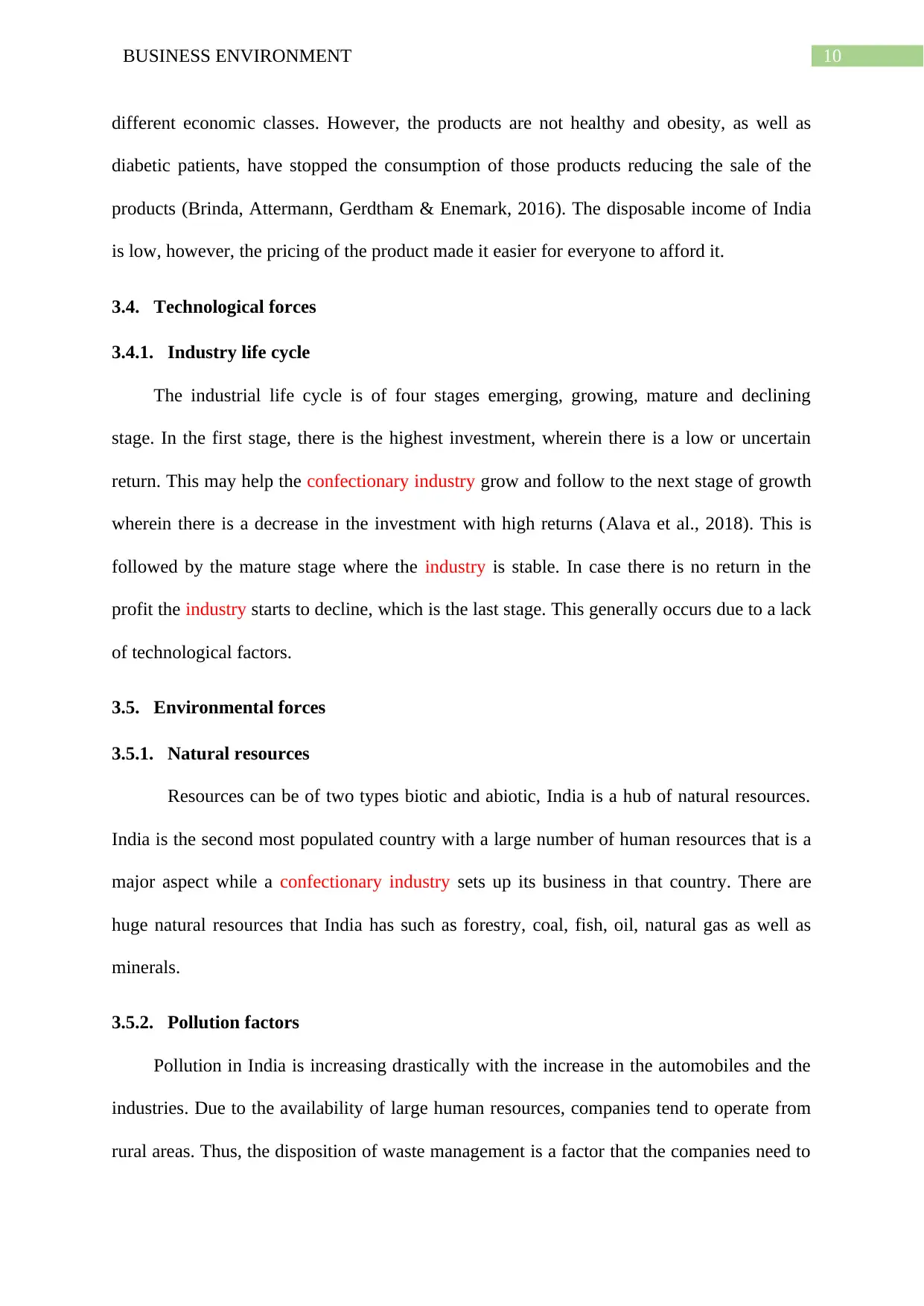
10BUSINESS ENVIRONMENT
different economic classes. However, the products are not healthy and obesity, as well as
diabetic patients, have stopped the consumption of those products reducing the sale of the
products (Brinda, Attermann, Gerdtham & Enemark, 2016). The disposable income of India
is low, however, the pricing of the product made it easier for everyone to afford it.
3.4. Technological forces
3.4.1. Industry life cycle
The industrial life cycle is of four stages emerging, growing, mature and declining
stage. In the first stage, there is the highest investment, wherein there is a low or uncertain
return. This may help the confectionary industry grow and follow to the next stage of growth
wherein there is a decrease in the investment with high returns (Alava et al., 2018). This is
followed by the mature stage where the industry is stable. In case there is no return in the
profit the industry starts to decline, which is the last stage. This generally occurs due to a lack
of technological factors.
3.5. Environmental forces
3.5.1. Natural resources
Resources can be of two types biotic and abiotic, India is a hub of natural resources.
India is the second most populated country with a large number of human resources that is a
major aspect while a confectionary industry sets up its business in that country. There are
huge natural resources that India has such as forestry, coal, fish, oil, natural gas as well as
minerals.
3.5.2. Pollution factors
Pollution in India is increasing drastically with the increase in the automobiles and the
industries. Due to the availability of large human resources, companies tend to operate from
rural areas. Thus, the disposition of waste management is a factor that the companies need to
different economic classes. However, the products are not healthy and obesity, as well as
diabetic patients, have stopped the consumption of those products reducing the sale of the
products (Brinda, Attermann, Gerdtham & Enemark, 2016). The disposable income of India
is low, however, the pricing of the product made it easier for everyone to afford it.
3.4. Technological forces
3.4.1. Industry life cycle
The industrial life cycle is of four stages emerging, growing, mature and declining
stage. In the first stage, there is the highest investment, wherein there is a low or uncertain
return. This may help the confectionary industry grow and follow to the next stage of growth
wherein there is a decrease in the investment with high returns (Alava et al., 2018). This is
followed by the mature stage where the industry is stable. In case there is no return in the
profit the industry starts to decline, which is the last stage. This generally occurs due to a lack
of technological factors.
3.5. Environmental forces
3.5.1. Natural resources
Resources can be of two types biotic and abiotic, India is a hub of natural resources.
India is the second most populated country with a large number of human resources that is a
major aspect while a confectionary industry sets up its business in that country. There are
huge natural resources that India has such as forestry, coal, fish, oil, natural gas as well as
minerals.
3.5.2. Pollution factors
Pollution in India is increasing drastically with the increase in the automobiles and the
industries. Due to the availability of large human resources, companies tend to operate from
rural areas. Thus, the disposition of waste management is a factor that the companies need to
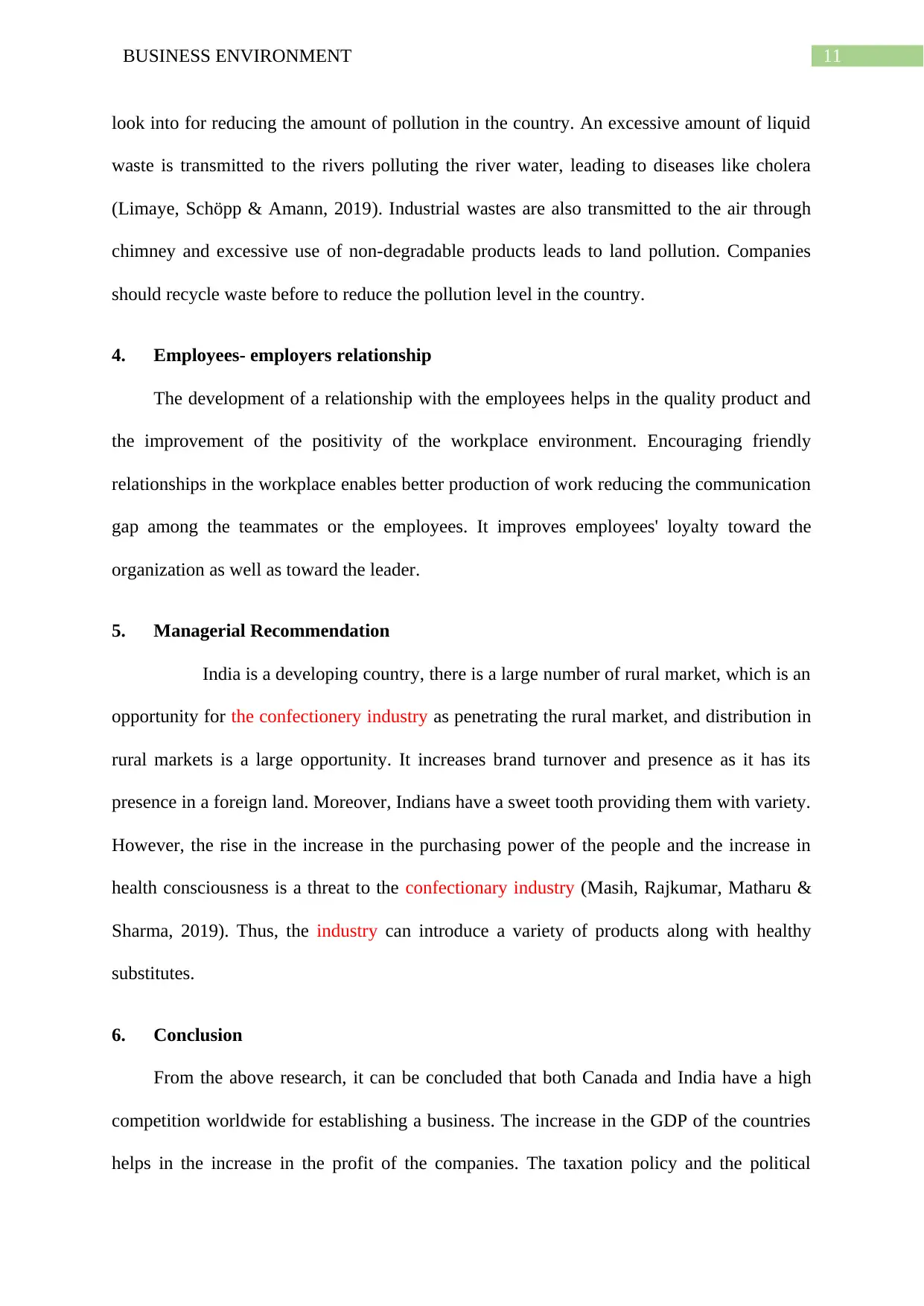
11BUSINESS ENVIRONMENT
look into for reducing the amount of pollution in the country. An excessive amount of liquid
waste is transmitted to the rivers polluting the river water, leading to diseases like cholera
(Limaye, Schöpp & Amann, 2019). Industrial wastes are also transmitted to the air through
chimney and excessive use of non-degradable products leads to land pollution. Companies
should recycle waste before to reduce the pollution level in the country.
4. Employees- employers relationship
The development of a relationship with the employees helps in the quality product and
the improvement of the positivity of the workplace environment. Encouraging friendly
relationships in the workplace enables better production of work reducing the communication
gap among the teammates or the employees. It improves employees' loyalty toward the
organization as well as toward the leader.
5. Managerial Recommendation
India is a developing country, there is a large number of rural market, which is an
opportunity for the confectionery industry as penetrating the rural market, and distribution in
rural markets is a large opportunity. It increases brand turnover and presence as it has its
presence in a foreign land. Moreover, Indians have a sweet tooth providing them with variety.
However, the rise in the increase in the purchasing power of the people and the increase in
health consciousness is a threat to the confectionary industry (Masih, Rajkumar, Matharu &
Sharma, 2019). Thus, the industry can introduce a variety of products along with healthy
substitutes.
6. Conclusion
From the above research, it can be concluded that both Canada and India have a high
competition worldwide for establishing a business. The increase in the GDP of the countries
helps in the increase in the profit of the companies. The taxation policy and the political
look into for reducing the amount of pollution in the country. An excessive amount of liquid
waste is transmitted to the rivers polluting the river water, leading to diseases like cholera
(Limaye, Schöpp & Amann, 2019). Industrial wastes are also transmitted to the air through
chimney and excessive use of non-degradable products leads to land pollution. Companies
should recycle waste before to reduce the pollution level in the country.
4. Employees- employers relationship
The development of a relationship with the employees helps in the quality product and
the improvement of the positivity of the workplace environment. Encouraging friendly
relationships in the workplace enables better production of work reducing the communication
gap among the teammates or the employees. It improves employees' loyalty toward the
organization as well as toward the leader.
5. Managerial Recommendation
India is a developing country, there is a large number of rural market, which is an
opportunity for the confectionery industry as penetrating the rural market, and distribution in
rural markets is a large opportunity. It increases brand turnover and presence as it has its
presence in a foreign land. Moreover, Indians have a sweet tooth providing them with variety.
However, the rise in the increase in the purchasing power of the people and the increase in
health consciousness is a threat to the confectionary industry (Masih, Rajkumar, Matharu &
Sharma, 2019). Thus, the industry can introduce a variety of products along with healthy
substitutes.
6. Conclusion
From the above research, it can be concluded that both Canada and India have a high
competition worldwide for establishing a business. The increase in the GDP of the countries
helps in the increase in the profit of the companies. The taxation policy and the political
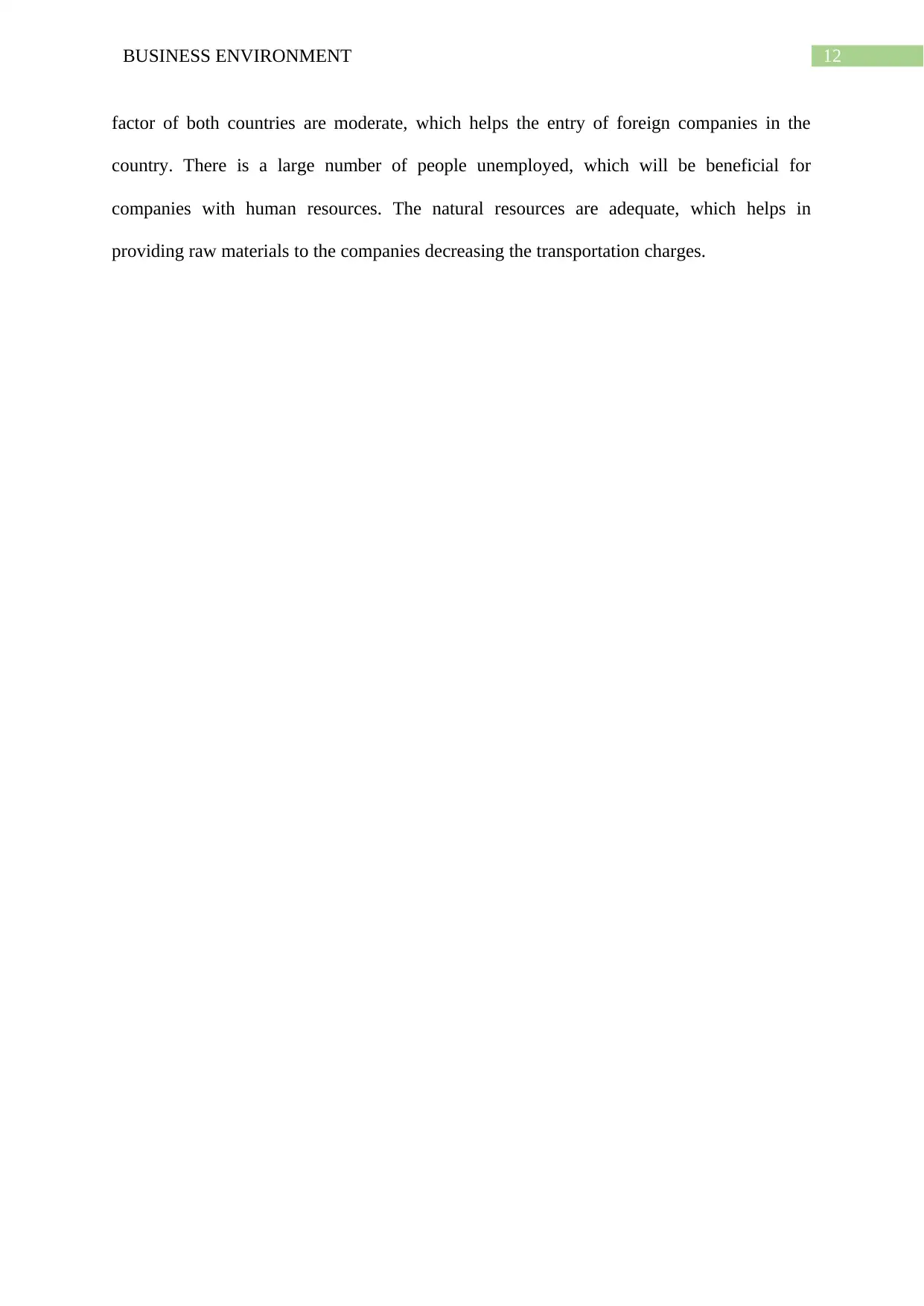
12BUSINESS ENVIRONMENT
factor of both countries are moderate, which helps the entry of foreign companies in the
country. There is a large number of people unemployed, which will be beneficial for
companies with human resources. The natural resources are adequate, which helps in
providing raw materials to the companies decreasing the transportation charges.
factor of both countries are moderate, which helps the entry of foreign companies in the
country. There is a large number of people unemployed, which will be beneficial for
companies with human resources. The natural resources are adequate, which helps in
providing raw materials to the companies decreasing the transportation charges.
Paraphrase This Document
Need a fresh take? Get an instant paraphrase of this document with our AI Paraphraser
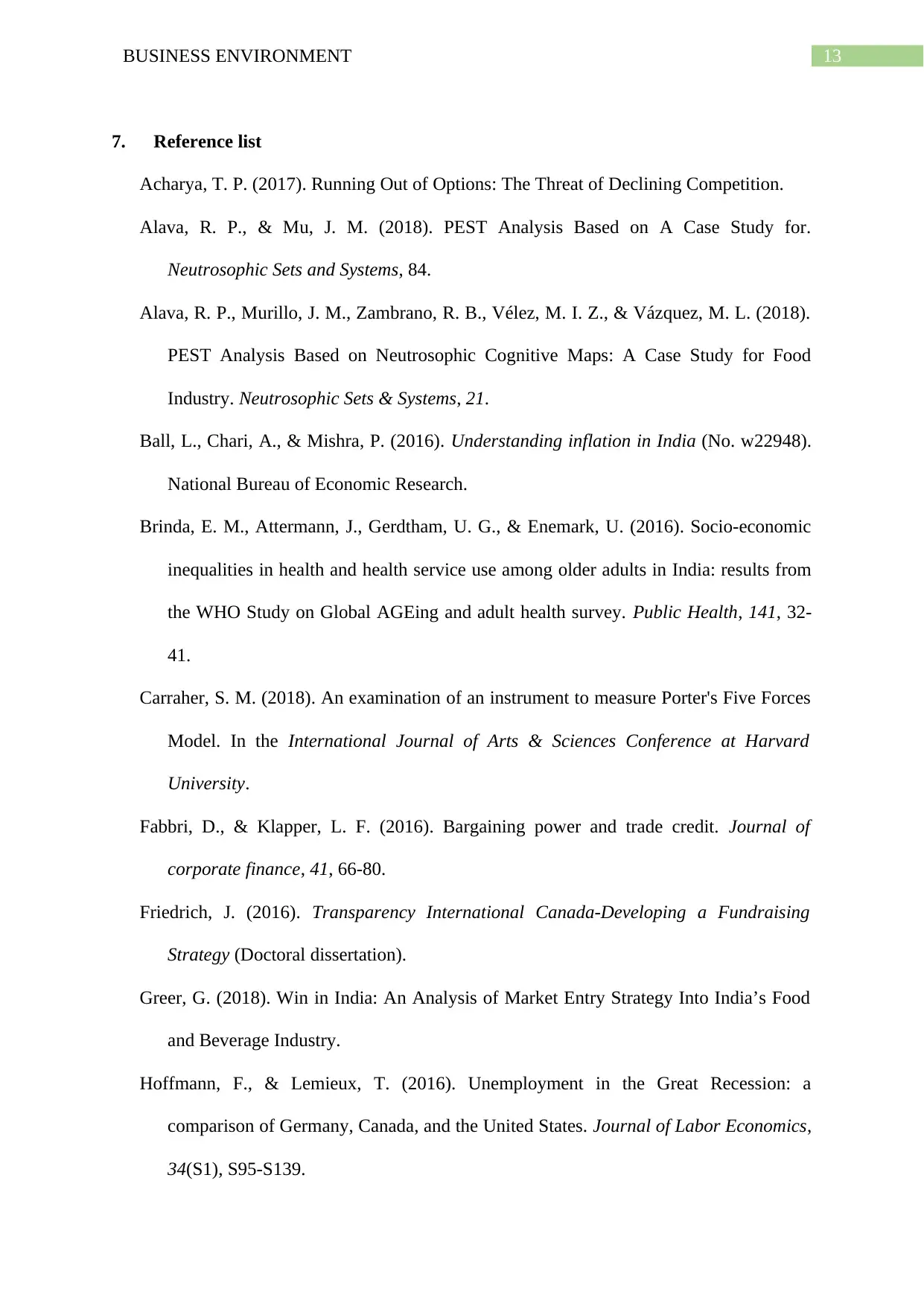
13BUSINESS ENVIRONMENT
7. Reference list
Acharya, T. P. (2017). Running Out of Options: The Threat of Declining Competition.
Alava, R. P., & Mu, J. M. (2018). PEST Analysis Based on A Case Study for.
Neutrosophic Sets and Systems, 84.
Alava, R. P., Murillo, J. M., Zambrano, R. B., Vélez, M. I. Z., & Vázquez, M. L. (2018).
PEST Analysis Based on Neutrosophic Cognitive Maps: A Case Study for Food
Industry. Neutrosophic Sets & Systems, 21.
Ball, L., Chari, A., & Mishra, P. (2016). Understanding inflation in India (No. w22948).
National Bureau of Economic Research.
Brinda, E. M., Attermann, J., Gerdtham, U. G., & Enemark, U. (2016). Socio-economic
inequalities in health and health service use among older adults in India: results from
the WHO Study on Global AGEing and adult health survey. Public Health, 141, 32-
41.
Carraher, S. M. (2018). An examination of an instrument to measure Porter's Five Forces
Model. In the International Journal of Arts & Sciences Conference at Harvard
University.
Fabbri, D., & Klapper, L. F. (2016). Bargaining power and trade credit. Journal of
corporate finance, 41, 66-80.
Friedrich, J. (2016). Transparency International Canada-Developing a Fundraising
Strategy (Doctoral dissertation).
Greer, G. (2018). Win in India: An Analysis of Market Entry Strategy Into India’s Food
and Beverage Industry.
Hoffmann, F., & Lemieux, T. (2016). Unemployment in the Great Recession: a
comparison of Germany, Canada, and the United States. Journal of Labor Economics,
34(S1), S95-S139.
7. Reference list
Acharya, T. P. (2017). Running Out of Options: The Threat of Declining Competition.
Alava, R. P., & Mu, J. M. (2018). PEST Analysis Based on A Case Study for.
Neutrosophic Sets and Systems, 84.
Alava, R. P., Murillo, J. M., Zambrano, R. B., Vélez, M. I. Z., & Vázquez, M. L. (2018).
PEST Analysis Based on Neutrosophic Cognitive Maps: A Case Study for Food
Industry. Neutrosophic Sets & Systems, 21.
Ball, L., Chari, A., & Mishra, P. (2016). Understanding inflation in India (No. w22948).
National Bureau of Economic Research.
Brinda, E. M., Attermann, J., Gerdtham, U. G., & Enemark, U. (2016). Socio-economic
inequalities in health and health service use among older adults in India: results from
the WHO Study on Global AGEing and adult health survey. Public Health, 141, 32-
41.
Carraher, S. M. (2018). An examination of an instrument to measure Porter's Five Forces
Model. In the International Journal of Arts & Sciences Conference at Harvard
University.
Fabbri, D., & Klapper, L. F. (2016). Bargaining power and trade credit. Journal of
corporate finance, 41, 66-80.
Friedrich, J. (2016). Transparency International Canada-Developing a Fundraising
Strategy (Doctoral dissertation).
Greer, G. (2018). Win in India: An Analysis of Market Entry Strategy Into India’s Food
and Beverage Industry.
Hoffmann, F., & Lemieux, T. (2016). Unemployment in the Great Recession: a
comparison of Germany, Canada, and the United States. Journal of Labor Economics,
34(S1), S95-S139.
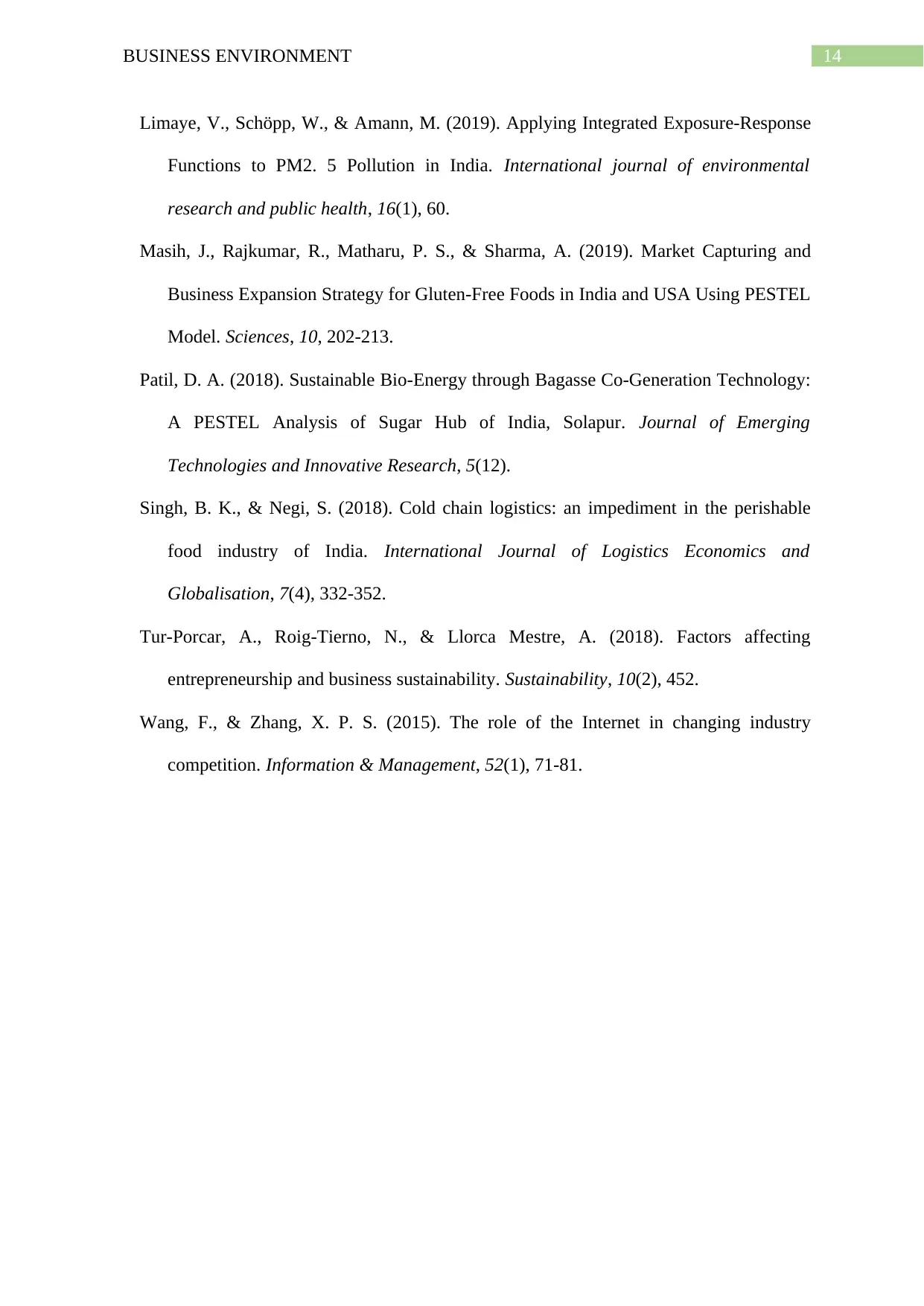
14BUSINESS ENVIRONMENT
Limaye, V., Schöpp, W., & Amann, M. (2019). Applying Integrated Exposure-Response
Functions to PM2. 5 Pollution in India. International journal of environmental
research and public health, 16(1), 60.
Masih, J., Rajkumar, R., Matharu, P. S., & Sharma, A. (2019). Market Capturing and
Business Expansion Strategy for Gluten-Free Foods in India and USA Using PESTEL
Model. Sciences, 10, 202-213.
Patil, D. A. (2018). Sustainable Bio-Energy through Bagasse Co-Generation Technology:
A PESTEL Analysis of Sugar Hub of India, Solapur. Journal of Emerging
Technologies and Innovative Research, 5(12).
Singh, B. K., & Negi, S. (2018). Cold chain logistics: an impediment in the perishable
food industry of India. International Journal of Logistics Economics and
Globalisation, 7(4), 332-352.
Tur-Porcar, A., Roig-Tierno, N., & Llorca Mestre, A. (2018). Factors affecting
entrepreneurship and business sustainability. Sustainability, 10(2), 452.
Wang, F., & Zhang, X. P. S. (2015). The role of the Internet in changing industry
competition. Information & Management, 52(1), 71-81.
Limaye, V., Schöpp, W., & Amann, M. (2019). Applying Integrated Exposure-Response
Functions to PM2. 5 Pollution in India. International journal of environmental
research and public health, 16(1), 60.
Masih, J., Rajkumar, R., Matharu, P. S., & Sharma, A. (2019). Market Capturing and
Business Expansion Strategy for Gluten-Free Foods in India and USA Using PESTEL
Model. Sciences, 10, 202-213.
Patil, D. A. (2018). Sustainable Bio-Energy through Bagasse Co-Generation Technology:
A PESTEL Analysis of Sugar Hub of India, Solapur. Journal of Emerging
Technologies and Innovative Research, 5(12).
Singh, B. K., & Negi, S. (2018). Cold chain logistics: an impediment in the perishable
food industry of India. International Journal of Logistics Economics and
Globalisation, 7(4), 332-352.
Tur-Porcar, A., Roig-Tierno, N., & Llorca Mestre, A. (2018). Factors affecting
entrepreneurship and business sustainability. Sustainability, 10(2), 452.
Wang, F., & Zhang, X. P. S. (2015). The role of the Internet in changing industry
competition. Information & Management, 52(1), 71-81.
1 out of 15
Related Documents
Your All-in-One AI-Powered Toolkit for Academic Success.
+13062052269
info@desklib.com
Available 24*7 on WhatsApp / Email
![[object Object]](/_next/static/media/star-bottom.7253800d.svg)
Unlock your academic potential
© 2024 | Zucol Services PVT LTD | All rights reserved.




